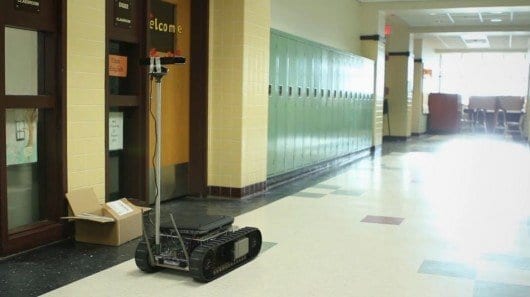
“Cognitive Patterns” features intelligent human-robot collaboration
Robots can be ideal in situations where humans are not, like entering a radioactive facility, or disposing of explosive ordinance. But even so, these mobile machines still require considerable human oversight as they lack the intelligence to respond to the unexpected on their own.
If robots are to become more autonomous and useful, how can they be made to understand the surroundings and situations that would be obvious to humans?
To address this challenge, Aptima has developed Cognitive Patterns, a knowledge-based, collaborative sense-making system for robots to better recognize, adapt to, and intelligently work with their human counterparts in novel situations. What makes Cognitive Patterns distinct is an architecture that borrows from the neuroscience of human perception and sense-making. First, the high-level knowledge on board the robot is combined with lower level sensor data so the robot can recognize a situation as much as possible on its own, just as humans do. Second, when confronted with ambiguous information or scenarios that don’t match its current knowledge, the system blends existing concepts to generate new knowledge for the robot, akin to the sense-making mind. Networked with the robot, the human operator can adjust how it categorizes objects, people, and environments, boosting the robot’s high-level knowledge and ability to draw conclusions from its sensory data.
Aptima, which applies expertise in human-inspired machine systems, developed the Cognitive Patterns prototype for DARPA‘s Defense Sciences Office and the US Army Research Laboratory’s Cognitive Robotics team. The ROS-compliant technology is expected to advance a new class of robots with higher level decision-making, in turn, lowering pre-mission preparation costs, minimizing the need for human intervention, and increasing mission flexibility.
“Even with their state-of-the-art sensors, robots aren’t capable of recognizing what they haven’t seen before, which severely limits their usefulness,” said Webb Stacy, Aptima’s Principal Investigator for the Cognitive Patterns contract. “They’re designed to operate from the bottom up. If the images hitting its camera don’t match what’s in its brain, they’re unable to understand what would be clear to us, which requires lots of ‘hand-holding’.
“Humans, on the other hand, make sense of the world from the top down. We blend concepts in our visual memory or mind’s eye that allows us to recognize a friend regardless of the clothing they wear, or identify an object as a coffee cup despite the innumerable colors, shapes, and sizes they come in,” Stacy added.
As an automated system, Cognitive Patterns combines both top-down and bottom up processing, allowing the robot and human to each do what they do best. It matches sensory input to abstract patterns in a manner similar to the mechanisms used for visual perception in the human brain. The result is a rich situation model shared between robot and human that could not have been created by either alone. The robot needs to interact with the operator only when something unusual or unexpected occurs and to receive mission orders.
The Latest Bing News on:
Human-robot collaboration
- Europe taps deep learning to make industrial robots safer colleagueson April 26, 2024 at 1:07 am
European researchers have launched the RoboSAPIENS project to make adaptive industrial robots more efficient and safer to work with humans.
- Humanoid Robot Market CAGR of 35%, Human Element of Consumer Behavior Unveiling Insights with Ethnography Techniqueson April 25, 2024 at 4:20 pm
Humanoid Robot Market is valued at approximately USD 1,107 million in 2019 and is anticipated to grow with a healthy growth rate of more than 35% over the forecast period 2020-2027. Humanoid robots ...
- Industrial Robots and Their Human Counterpartson April 23, 2024 at 8:35 am
The conversation around robots and their use in manufacturing has long been controversial. Many fear that the introduction of robots into the workplace will displace human jobs. In some respects, yes, ...
- This robot is tackling litter on Belle Isle Beachon April 22, 2024 at 9:13 am
If you’re looking to automate more of your home cleaning setup, iRobot’s flagship Roomba Combo J9+ is on sale for $400 off. The vacuum-mop hybrid robot, which only arrived last fall, has a redesigned ...
- Top 6 Humanoid Robot Companies To Consider As A New Trend Potentially Takes Offon April 22, 2024 at 8:37 am
Discover the booming global market for humanoid robots set to reach $38 billion by 2035. Click for a full review of current humanoid robotics firm developments.
- How the Optimus Tesla Bot humanoid robot is madeon April 22, 2024 at 5:21 am
Tesla, renowned for its groundbreaking innovations in electric vehicles and sustainable energy, has moving into the realm of humanoid robotics over the ...
- Moxi, healthcare robot created in Austin, completes 500k deliverieson April 20, 2024 at 3:54 pm
Diligent Robotics' AI-powered Moxi robots assist nurses in 30+ hospitals, handling menial tasks like deliveries, saving time and reducing burnout.
- Robots can make jobs less meaningful for human colleagueson April 18, 2024 at 11:46 am
Much has been (and will continue to be) written about automation’s impact on the jobs market. One aspect of the conversation that is oft neglected, however, is how human workers feel about their ...
- Boston Dynamics revamps its humanoid robot Atlas with electric motorson April 17, 2024 at 7:01 pm
Boston Dynamics Inc., the robotics startup famed for its advanced humanoid and dog-like robots that went viral in years gone by for their acrobatic movements and dances, today announced it’s retiring ...
- How 3D printers can give robots a soft touchon April 17, 2024 at 2:36 pm
More information: Kyungseo Park et al, Low-Cost and Easy-to-Build Soft Robotic Skin for Safe and Contact-Rich Human–Robot Collaboration, IEEE Transactions on Robotics (2024). DOI: ...
The Latest Google Headlines on:
Human-robot collaboration
[google_news title=”” keyword=”human-robot collaboration” num_posts=”10″ blurb_length=”0″ show_thumb=”left”]
The Latest Bing News on:
Human-inspired machine systems
- 'Inspired by the human brain': Intel debuts neuromorphic system that aims to mimic grey matter with a clear aim — making the machine exponentially faster and much more power ...on April 27, 2024 at 10:40 pm
Intel's Hala Point is the world's largest “brain-based” computing system with 1.15 billion artificial neurons.
- Study explores why human-inspired machines can be perceived as eerieon April 25, 2024 at 4:40 am
Artificial intelligence (AI) algorithms and robots are becoming increasingly advanced, exhibiting capabilities that vaguely resemble those of humans. The growing similarities between AIs and humans ...
- Why animals run faster than their robot doppelgängers… for nowon April 24, 2024 at 11:00 am
“It [advances in robots] will move faster, because evolution is undirected,” University of Washington Department of Electrical & Computer Engineering Associate Professor Sam Burden said. “There are ...
- World leading expert on bio-inspired AI to direct University of Sheffield’s Centre for Machine Intelligenceon April 22, 2024 at 3:03 am
One of the world’s leading innovators in bio-inspired AI has joined the University of Sheffield, as part of a new multi-million pound centre that is set to transform the institution’s research, ...
- Daddy long-legs-inspired robot could one day squirm through Martian caveson April 17, 2024 at 11:00 am
The spiderbot's extendable legs can grasp onto uneven rock surfaces and propel it forward.
- Intel reveals world's biggest 'brain-inspired' neuromorphic computeron April 17, 2024 at 8:51 am
A computer intended to mimic the way the brain processes and stores data could potentially improve the efficiency and capabilities of artificial intelligence models ...
- Shrimp-inspired nanoclusters enable multifunctional artificial vision systemson April 16, 2024 at 5:01 pm
10.1038/s41467-024-46646-5) Advances in artificial intelligence and autonomous systems have triggered increasing interest in artificial vision systems (AVSs) in recent years. Artificial vision allows ...
- Modeling the Human Immune Systemon March 30, 2024 at 7:54 am
When the Human Genome Project mapped and ... founding director of the Yale Center for Systems and Engineering Immunology. Researchers, inspired by large language models, are building foundation ...
- Engineers collaborate with ChatGPT4 to design brain-inspired chipson March 5, 2024 at 9:53 am
real-time machine intelligence for next-generation embodied systems like autonomous vehicles and robots. Electrical and computer engineering graduate student Michael Tomlinson and undergraduate ...
- Google Crafts ‘Robot Constitution’ Inspired By Isaac Asimov’s Laws Of Roboticson January 10, 2024 at 2:02 pm
Isaac Asimov’s famous Three Laws of Robotics inspired ... develop new systems aimed at ultimately making our robot buddies faster and better at understanding and navigating human-centered ...
The Latest Google Headlines on:
Human-inspired machine systems
[google_news title=”” keyword=”human-inspired machine systems” num_posts=”10″ blurb_length=”0″ show_thumb=”left”]










